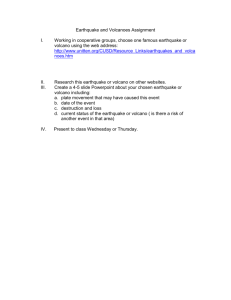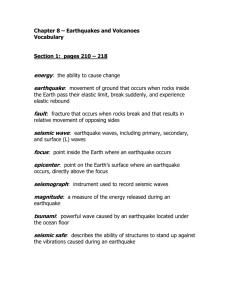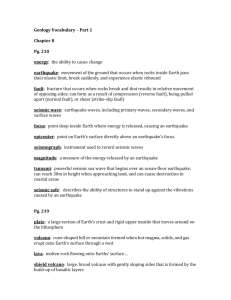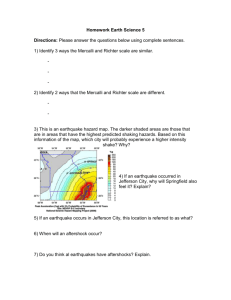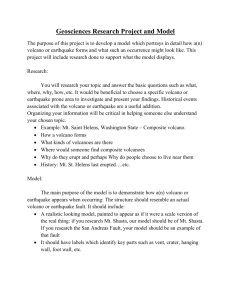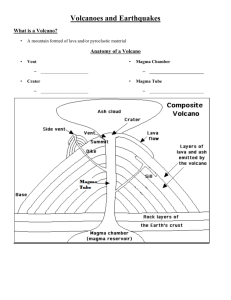Earthquake and Volcano Test
advertisement
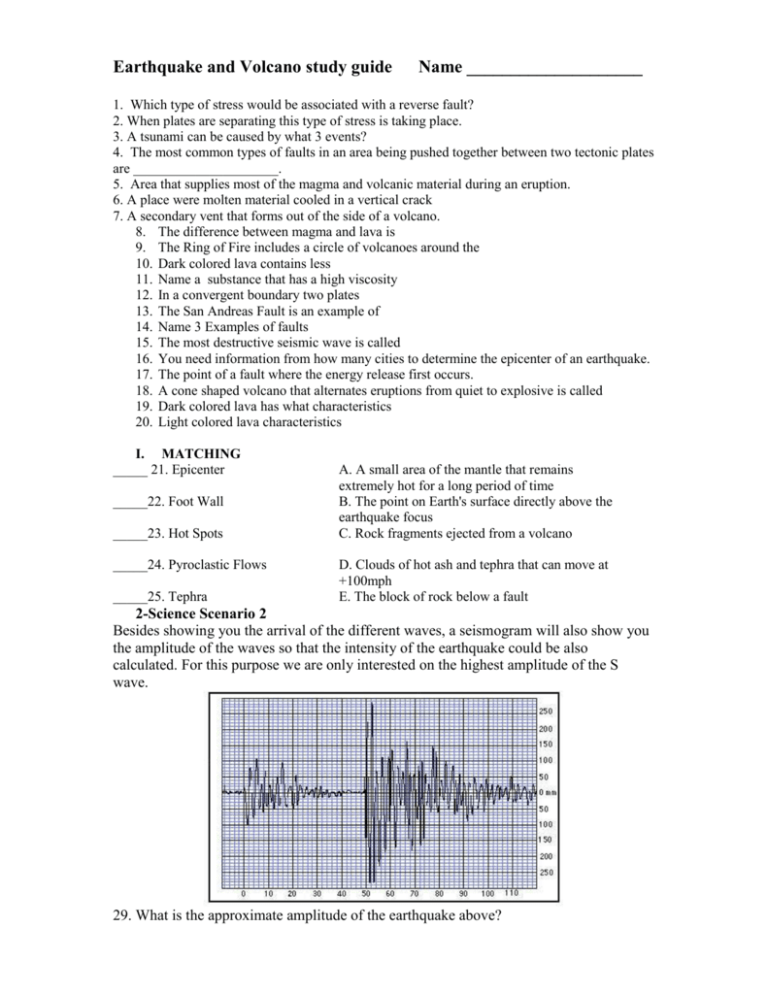
Earthquake and Volcano study guide Name ____________________ 1. Which type of stress would be associated with a reverse fault? 2. When plates are separating this type of stress is taking place. 3. A tsunami can be caused by what 3 events? 4. The most common types of faults in an area being pushed together between two tectonic plates are _____________________. 5. Area that supplies most of the magma and volcanic material during an eruption. 6. A place were molten material cooled in a vertical crack 7. A secondary vent that forms out of the side of a volcano. 8. The difference between magma and lava is 9. The Ring of Fire includes a circle of volcanoes around the 10. Dark colored lava contains less 11. Name a substance that has a high viscosity 12. In a convergent boundary two plates 13. The San Andreas Fault is an example of 14. Name 3 Examples of faults 15. The most destructive seismic wave is called 16. You need information from how many cities to determine the epicenter of an earthquake. 17. The point of a fault where the energy release first occurs. 18. A cone shaped volcano that alternates eruptions from quiet to explosive is called 19. Dark colored lava has what characteristics 20. Light colored lava characteristics I. MATCHING _____ 21. Epicenter _____22. Foot Wall _____23. Hot Spots _____24. Pyroclastic Flows _____25. Tephra A. A small area of the mantle that remains extremely hot for a long period of time B. The point on Earth's surface directly above the earthquake focus C. Rock fragments ejected from a volcano D. Clouds of hot ash and tephra that can move at +100mph E. The block of rock below a fault 2-Science Scenario 2 Besides showing you the arrival of the different waves, a seismogram will also show you the amplitude of the waves so that the intensity of the earthquake could be also calculated. For this purpose we are only interested on the highest amplitude of the S wave. 29. What is the approximate amplitude of the earthquake above? 3- Science Scenario 1 Examine the seismogram below that shows a 26-minute long record of the seismic waves from the 1906 San Francisco earthquake as it was received by a seismograph station in Germany, over 14,000 km away. 26. Which letter represents the arrival of the first S waves? 27. Which letter represents the arrival of the first P waves? 28. Approximately how much time elapsed between the arrival of the first P and S waves? II. Science Scenario 3 A nomogram will help you to determine the magnitude (intensity) of an earthquake. The nomogram on the right gives the magnitude based in the Ritcher scale. Simply by creating lines between the distance from the earthquake to the amplitude of the S wave we could determine the magnitude of the earthquake. 30. What is the approximate magnitude of the above earthquake? III. Short Essay (10 points) Surtsey, is part of a chain of islands that extend southward from the (main) island of Iceland. The volcano that makes up this island may be older but the island itself was born on 15 Nov, 1963. Eruptions actually started below sea level about a half of a year prior to this. They were detected and located by earthquake activity (seismic tremors) in the area. Earliest indications of an impending eruption at the surface were from water temperature increases of 7-9 °C at the sea surface, about 45 days before the above-sea-level eruptions began. The 1963 eruption actually started at over 100 meters water depth. As the volcano neared the surface, the eruptions created large explosions. When it neared the surface it produced an eruption column composed mostly of volcanic ash. The first observations of an eruption column were by Ólafur Vestman. He observed the volcanic debris from a ship on the morning of Nov. 14, 1963. Eventually, the volcano grew above sea level, lava flows were erupted, and a cone formed. Basaltic lava flows first erupted April 4, 1964. All eruptions ceased in 1967. This pyroclastic to lava flow transition occurred after the volcano had breached sea level and had built up a cone that was large enough to keep sea water out of its eruption crater. Today, the island is being eroded by the large waves of North Atlantic Ocean and will probably disappear unless it erupts anew. It is presently volcanically quiet. What type of volcano was Surtsey and use at least 3 sources of evidence from the text to support your conclusion.

